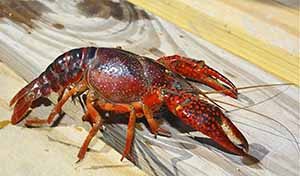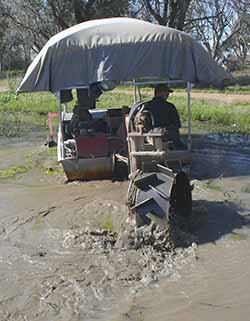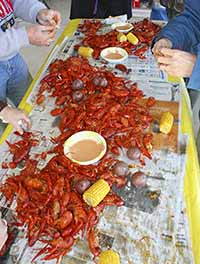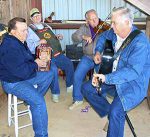
A crawfish trying to get away.
Growing and eating crawfish in and around Lake Charles, La. has always been the ultimate experience for local residents. Despite the decline of traditional farming and the importation of foreign crawfish, growing of these “Cajun Mudbugs” has become a huge industry in recent years, and being successful takes little more than land and good water.
Crawfish are everywhere in the rich bayou lands of Southwest Louisiana. Therefore, one only has to level the land, build dikes capable of holding back about 3 feet of water, add water with excellent quality, and wait for the crawfish to come.
“When the crawfish come,” said a local farmer, “I have to continually move water through a staggered levee system to keep my crawfish alive and active. They’ve got to have good levels of oxygen to prosper. Catching them after they have grown, however, is a different story.”

Stirring up mud in the crawfish pond
Two factors provide a feeling of security for the fast-growing mudbugs. These are muddy water and darkness. The clearer the water, the more active the crawfish are at night. Muddy water provides enough security for crawfish to remain active during the day.
“I’ve seen it time and time again when running traps,” said the farmer. “If you put a trap out in clear water and come back an hour later, you won’t have any crawfish. Come back in five hours and you may have a couple. Yet, if you come back the next morning, you’ll have a pound or so. But, when you set that trap in muddy water, you can come back in an hour and have 1 or 2 pounds.”
Because many of the wetlands where crawfish have always grown naturally have, or are being destroyed by man, most of the crawfish crop today is harvested from created farms. In fact, about 85% of the 100 million pounds of crawfish produced each year come from farms in Louisiana.

Eating is the Best Part of a Crawfish Boil
The art of eating crawfish peaks during the spring and summer seasons. Whether you call them les e’crevisses, crawfish, crawdads, crayfish or Cajun mudbugs, it’s the eating and party atmosphere that accompanies this unique experience that is unforgettable! Even if you don’t suck the juices out of the head, every cook’s own secret recipe will have you soon piling up stacks of bright orange shells as you consume an average of 5 to 10 pounds of these tasty freshwater lobsters before you realize what you have done.
Cajun country in and around Lake Charles is a virtual plethora of legendary and mouthwatering cuisine. One can feast on such prize dishes as shrimp, crawfish etouffee, crawfish pie, oyster, shrimp or crawfish po boys, catfish, fried gator tails, crabmeat, redfish and, of course, world famous gumbo that is prepared differently by every chef! The best part of Lake Charles and all of Southwest Louisiana, however, is its wonderful, friendly people who consider you as part of their extended family as soon as you first greet them. Therefore, this historical and colorful section of our country is certainly a destination that all Americans should experience during their lifetime!

Mardi Gras fun!

Dancing to Zydeco music

Zydeco Music and Crawfish Boiling go together.
For more information about planning a trip to this area, contact: Southwest Louisiana Convention & Visitors Bureau (www.visitlakecharles.org) or Jeff Davis Parish Tourist Commission (www.jeffdavis.org).
Photos: by Bill Vanderford




